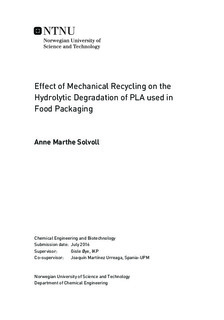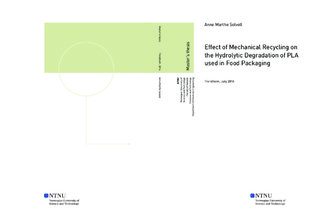| dc.description.abstract | The demand for plastic continues to increase, and the search for sustainable solutions has
become crucial for the large demand the world is facing today. The biopolymer polylactic acid
(PLA) has generated special interest, especially for packaging in the food industry, due to its
optical and mechanical properties, biocompatibility, and biodegradability.
The aim of this Master`s thesis was to examine the water uptake of mechanically recycled PLA,
and consequently the hydrolytic degradation with the prospect of using the material as packaging
material. It was compared with virgin PLA, to obtain information about the behaviour of the
material in the recycled state.
The primary challenge with PLA regarding its use in different applications is its facility to
undergo hydrolytic degradation in the presence of water. In hydrolytic degradation the ester
bonds of the molecules undergo hydrolysis, leading to a decrease in average molecular weight
and a worsening of mechanical properties and the stability of the material, which may render it
useless for some applications. Therefore, it was necessary to test the utility of mechanical
recycling of PLA and its nanocomposites by studying its resistance to hydrolytic degradation in
comparison with the virgin material.
Commercial PLA pellets were purchased, which could be used just as they were, but a 2%
Cloisite 30B clay was added to half of the PLA material. The pellets were prepared by
extrusion and, half of the samples were exposed to accelerated ageing, cleaning and finally,
mechanically reprocessed to simulate the recycling process. The PLA was immersed for different
times in a buffer solution to maintain neutral conditions concerning hydrolytic degradation.
UV-Vis spectroscopy of the immersion liquid presented spectra that illustrated three bands
located at 228, 246 and 290 nm. These bands grow with increasing immersion time and can be
assigned to oligomers of low molecular weight, lactide, lactic acid and lactoyllactic acid that are
formed during the hydrolytic degradation of PLA. The PLA endured hydrolytic degradation, and
the small molecules formed migrated to the liquid during this process. The FTIR analysis
presented the existence of four types of interactions between water and polymer that can be
distinguished as very strongly-, strongly-, weakly- and very weakly absorbed water.
Fickian behaviour was assumed for the water diffusion up until two days of immersion and by
this assumption, the diffusion coefficients were calculated. The diffusion coefficients for the
recycled materials with and without clay were calculated to be 3.5·10-12 and 7.1·10-12 m2/s
respectively. Clay caused increased water absorption in the material, due to its hydrophilicity,
and when dispersed as layers in the polymer it acts as a barrier preventing the passage of water.
Thus, the material with clay has a lower diffusion coefficient, which may be important to slow
the absorption of water in early stages, extending the life of the materials made with PLA. The
recycling of the material caused a small degradation, altering the molecular structure of the
polymer and thus, providing faster diffusion of water.
The measured intrinsic viscosity decreased with immersion time, and the degradation occurred
more rapidly in the recycled material compared to the virgin material and even faster in the
material with clay. Thermogravimetric analysis indicated that the thermal stability of the material
is reduced with immersion time due to degradation and that the stability of the recycled material,
is slightly inferior to the virgin material. The material with clay also showed to be inferior
regarding the thermal stability, compared to the material without clay.
The results obtained in this project provided information on the water absorption and hydrolytic
degradation of PLA, and about the effect on factors such as the presence of a layered clay or
mechanical recycling of the plastic. Recycling has a slight negative effect on the material, where
it increases the diffusion coefficient compared to the virgin material. The presence of clay sheets
well dispersed in the polymer may slow the absorption of water, which can slow the first stages
of the hydrolytic degradation.
The mechanical recycling, when no demanding cleaning steps are included in the process, gives
materials with good properties, very similar to those corresponding to the virgin materials. The
results obtained in this work appear to indicate that these recycled materials could be used in
packaging. When a demanding cleaning step is included in the recycling process, the recycled
materials show decreased stability, although the difference is small. These results support the
feasibility of the mechanical recycling of PLA. | |

